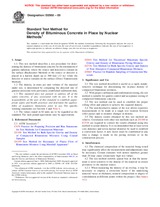Potřebujeme váš souhlas k využití jednotlivých dat, aby se vám mimo jiné mohly ukazovat informace týkající se vašich zájmů. Souhlas udělíte kliknutím na tlačítko „OK“.
ASTM D2950-09
Standard Test Method for Density of Bituminous Concrete in Place by Nuclear Methods
Automaticky přeložený název:
Standardní zkušební metoda pro Hustota Asfaltový beton na místě jaderných metod
NORMA vydána dne 1.6.2009
Informace o normě:
Označení normy: ASTM D2950-09
Poznámka: NEPLATNÁ
Datum vydání normy: 1.6.2009
Kód zboží: NS-22064
Počet stran: 5
Přibližná hmotnost: 15 g (0.03 liber)
Země: Americká technická norma
Kategorie: Technické normy ASTM
Anotace textu normy ASTM D2950-09 :
Keywords:
bituminous-concrete density, density, in-place density, nuclear test method, Concrete, Density--paving materials, Gamma radiation--soil/rock, Neutron radiation--concrete, Nuclear methods, ICS Number Code 93.080.10 (Road construction)
Doplňující informace
| Significance and Use | ||||||||||||
|
The test method described is useful as a rapid, nondestructive technique for determining the in-place density of compacted bituminous mixtures. With proper calibration and confirmation testing, the test method is suitable for quality control and acceptance testing of compacted bituminous concrete. The test method can be used to establish the proper rolling effort and pattern to achieve the required density. The non-destructive nature of the test allows repetitive measurements to be made at a single test location between roller passes and to monitor changes in density. The density results obtained by this test method are relative. Correlation with other test methods such as D 1188 or D 2726 are required to convert the results obtained using this method to actual density. It is recommended that at least seven core densities and seven nuclear densities be used to establish a conversion factor. A new factor must be established at any time a change is made in the paving mixture or in the construction process. |
||||||||||||
| 1. Scope | ||||||||||||
|
1.1 This test method describes a test procedure for determining the density of bituminous concrete by the attenuation of gamma radiation, where the source and detector(s) remain on the surface (Backscatter Method) or the source or detector is placed at a known depth up to 300 mm (12 in.) while the detector or source remains on the surface (Direct Transmission Method). 1.2 The density, in mass per unit volume of the material under test, is determined by comparing the detected rate of gamma emissions with previously established calibration data. 1.3 This standard does not purport to address all of the safety concerns, if any, associated with its use. It is the responsibility of the user of this standard to establish appropriate safety and health practices and determine the applicability of regulatory limitations prior to use. For specific warning statements see Section 6 and Note 4. 1.4 The values stated in SI units are to be regarded as the standard. The inch-pound equivalents may be approximate. |
||||||||||||
| 2. Referenced Documents | ||||||||||||
|




 Cookies
Cookies
